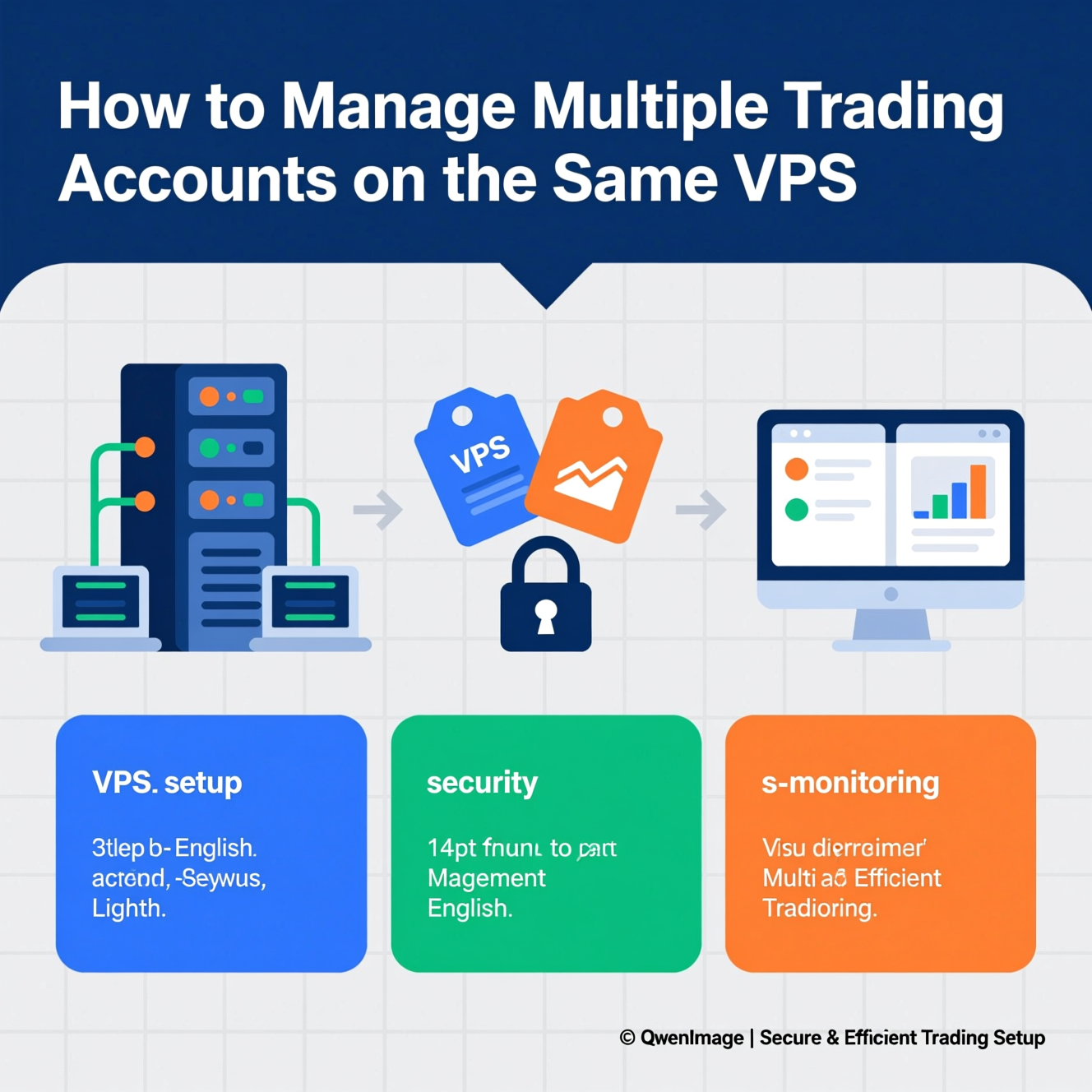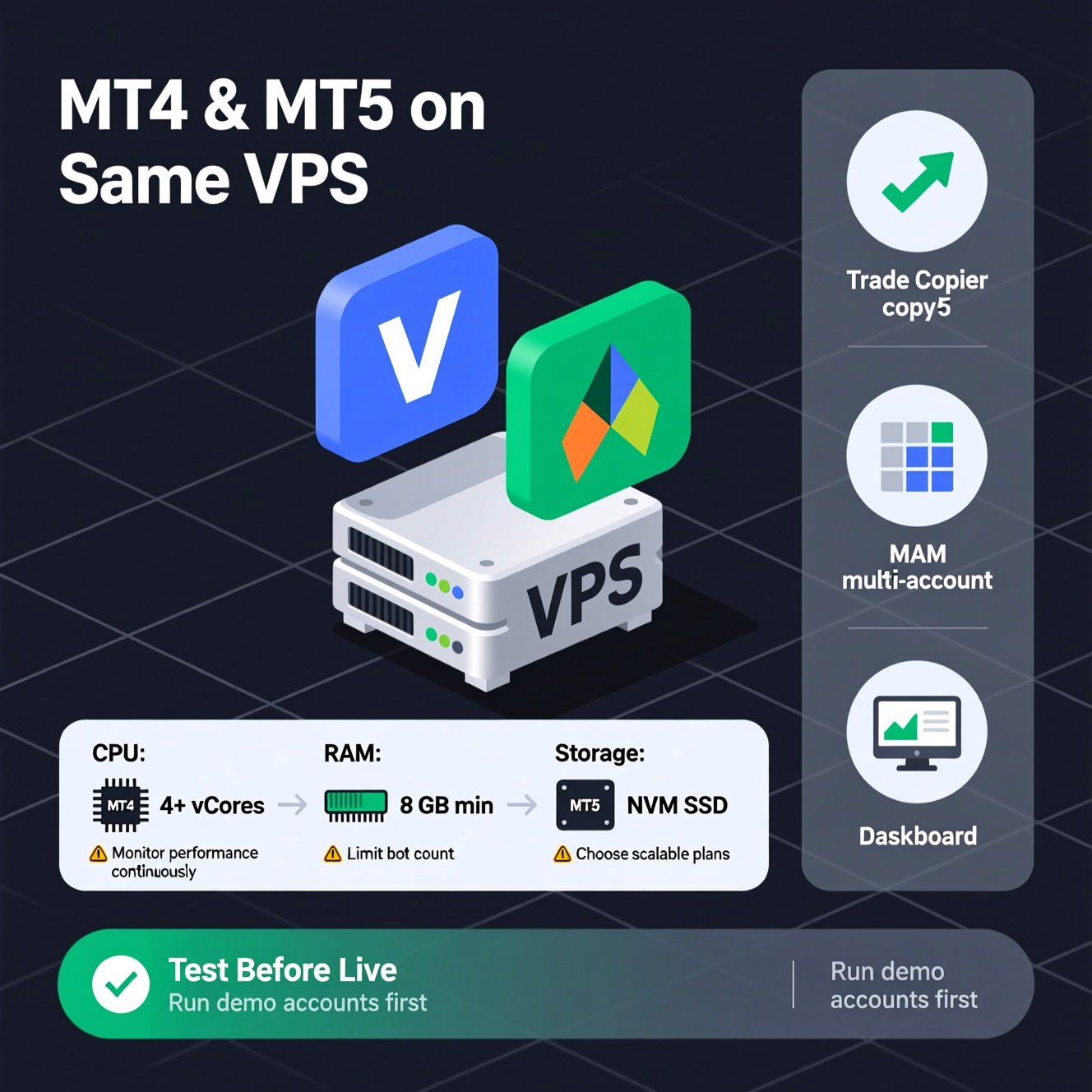In the modern trading world, VPS servers (Virtual Private Servers) have become essential tools for professional traders who want stability, speed, and security when managing their accounts.
But the key question is: Can you run multiple trading accounts on the same VPS?
The answer is yes — provided the server is configured correctly, resources are distributed wisely, and risks are properly managed.
In this comprehensive guide, we’ll walk you through every step of managing multiple Forex accounts on a single VPS — from setup to monitoring and optimization.

The first and most crucial step in managing multiple trading accounts is selecting a reliable VPS provider, as performance heavily depends on infrastructure quality.
Server location:
Choose a VPS provider with data centers close to your broker’s servers to minimize latency.
Security:
Ensure the VPS has a strong firewall, antivirus protection, and SSL encryption.
Technical support:
Opt for a provider offering 24/7 live chat support.
Uptime reliability:
Look for at least 99.99% uptime for continuous operation.
System resources:
Select a VPS plan based on the number of trading platforms you’ll run:
1 account → 1 GB RAM
2–4 accounts → 2–4 GB RAM
More than 4 accounts → 8 GB+ RAM
Once you receive your login credentials, connect to your VPS using Remote Desktop Connection (RDP) on Windows.
Enter your IP address, username, and password.
? Tip: Keep your credentials secure and never share them with anyone.
Open your browser inside the VPS.
Download MT4 or MT5 from your broker’s official website or from MetaQuotes.
Install the first platform using the default directory.
You’ll later need to repeat this process to create multiple instances of MetaTrader.
To run several accounts, you must install independent copies of the platform.
During the second installation, change the installation path, for example:C:\Program Files (x86)\MetaTrader 4 - 2
Repeat the process for each additional account you want to run.
Create desktop shortcuts for easy access.
Open each MetaTrader instance separately.
Log in to each trading account using your broker credentials.
Configure charts, indicators, and Expert Advisors (EAs) for each account.
Save individual profile settings to avoid conflicts between platforms.
Running multiple accounts requires careful resource management to ensure smooth and stable performance.
CPU and RAM usage:
1 GB RAM per single account
4 GB RAM for 4 accounts running simultaneously
Performance monitoring:
Use Task Manager to track CPU and memory usage.
Optimization:
Close unnecessary charts or indicators
Disable unused Expert Advisors
Use NVMe SSD storage for faster loading times
? Keep CPU usage below 80% to avoid slowdowns during high trading activity.
You can run MT4 and MT5 simultaneously on the same VPS, as long as your server is powerful enough.
Recommended specs:
CPU: 4 vCores or more
RAM: 8 GB minimum
Storage: NVMe SSD
Continuously monitor VPS performance
Avoid running too many bots at once
Choose scalable VPS plans for future expansion
Professional traders often use tools that simplify managing multiple accounts efficiently.
Popular tools:
Trade Copier: Automatically copies trades from a master account to others.
MAM (Multi Account Manager): Allows centralized trade execution across multiple accounts.
Dashboard Management Tools: Provide real-time monitoring for all accounts in one place.
Before going live, test every platform to ensure trading robots and indicators run properly.
Use built-in monitoring tools to check for speed, execution time, and stability.
Run demo accounts first to confirm performance before using real money.

Platform crashes due to excessive resource usage
Slow response when too many accounts run simultaneously
Connection interruptions from poor network performance
Solutions:
Use a high-quality, low-latency VPS
Monitor performance daily
Enable automatic alerts for execution errors
Compounded losses if all accounts use identical strategies
Over-hedging leading to higher costs and trade conflicts
Mitigation:
Use trade copy systems with diversified strategies
Create sub-accounts to spread financial exposure
Trade only with regulated and reliable brokers
To maintain stable performance:
Keep your system and platforms up to date
Regularly monitor CPU, RAM, and disk usage
Enable automatic backups
Avoid running unnecessary applications
Activate firewall and antivirus protection
Managing multiple Forex trading accounts on a single VPS gives you greater control, speed, and flexibility.
However, success depends on proper setup, smart resource distribution, and continuous monitoring.
By following the steps in this guide, you can run multiple accounts securely and efficiently — achieving professional-level automated trading 24/7.
هل تحتاج إلى Windows VPS سريع وآمن وبسعر مناسب؟
شركة EgyVPS بتوفرلك سيرفرات ويندوز جاهزة للاستخدام فورًا.
? تواصل معنا عبر: 201001197157
? أو زور موقعنا: https://egyvps.com